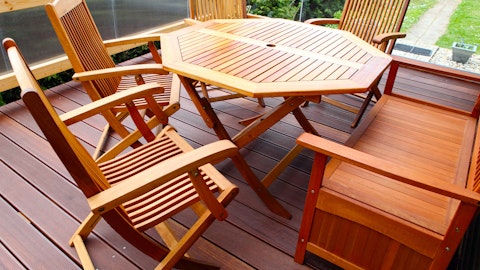Ethan Allen Interiors Inc. (NYSE:ETD) Q1 2024 Earnings Call Transcript October 25, 2023
Ethan Allen Interiors Inc. misses on earnings expectations. Reported EPS is $0.63 EPS, expectations were $0.72.
Operator: Good afternoon. And welcome to the Ethan Allen Fiscal 2024 First Quarter Analyst Conference Call. [Operator Instructions] Please note this conference is being recorded. It is now my pleasure to introduce your host, Matt McNulty, Senior Vice President, Chief Financial Officer and Treasurer. Thank you. You may begin.
Matt McNulty: Thank you, Doug. Good afternoon. And thank you for joining us today to discuss Ethan Allen’s fiscal 2024 first quarter results. With me today is Farooq Kathwari, our Chairman, President and CEO. Mr. Kathwari will open and close our prepared remarks, while I will speak to our financial performance midway through. After our prepared remarks, we will then open the call for your questions. Before we begin, I’d like to remind the audience that this call is being recorded and webcast live under the News and Events tab on the Investor Relations page of our website. There, you will find a copy of our press release, which contains reconciliations of non-GAAP financial measures referred to on this call and in this press release.
A replay of today’s call will also be made available on our Investor Relations website. Our comments today may include forward-looking statements that are subject to risks and uncertainties that could cause actual results to differ materially. The most significant risk factors that could affect our future results are described in our annual report on Form 10-K. Please refer to our SEC filings for a complete review of those risks. The company assumes no obligation to update or revise any forward-looking matters discussed during this call. With that, I am pleased to now turn the call over to Mr. Kathwari.
Farooq Kathwari: Thank you, Matt, and good to have you join our call to review our first fiscal 2024 results and our initiatives. As we reported, we maintained strong operating margins, gross margin of 61.1% and operating margin of 12.1% despite a decline of delivered sales of 23.6%. Our sales were impacted due to soft — due to softening of the economy and the impact of a major flood in our Vermont manufacturing operations. We are positioned well. We have continued to strengthen our vertically integrated enterprise. We have also continued to maintain a strong cash balance. During the quarter, we distributed $0.36 of regular and $0.50 of special dividend, and we also yesterday announced a regular dividend of $0.36 in addition to these two.
After Matt provides a brief overview of our financial results, I will discuss our various initiatives in growing and growing our business by positioning us as an interior design destination, strengthening our talent, marketing, manufacturing, logistics and our unique retail network providing interior design service increasingly combined with technology. Matt?
Matt McNulty: Thank you, Mr. Kathwari. As a reminder, we present our financial results on both a GAAP and non-GAAP basis. Non-GAAP results exclude restructuring initiatives, impairments, unusual or infrequently occurring events such as Vermont flood and other corporate actions. We believe the non-GAAP presentation better reflects underlying operating trends and performance of the business. Our financial results in the just completed first quarter are highlighted by strong margins, sales being impacted by July flooding at our Vermont case goods plants, positive operating cash flow, the payment of a special cash dividend and a robust balance sheet. Despite operating in a softening economy, our operations produced positive financial results, which I will now discuss.
Our consolidated net sales totaled $163.9 million, a decrease of 23.6% due to lower delivered unit volume from softening order demand, reduced manufacturing production from lower backlog, a strong comparable prior year and the impact from the Vermont flooding, which resulted in a temporary work stoppage and lowered net sales by approximately $15 million in the quarter. Our Orleans plant has since resumed operations and we expect to recover from the delayed shipments during the upcoming second and third quarters. Sales in the first quarter a year ago set a near record pace as we work through historically high backlog, leading to a difficult comparison. From a demand perspective, we are back to more normal conditions, down from the high demand we experienced during the height of the pandemic.
Wholesale segment written orders decreased 15.6% compared to last year, while retail segment written orders were down 13.2%. We ended the quarter with wholesale backlog of $75.4 million, down 28.6% from a year ago, but up $1.4 million since June 30, 2023, due to the timing of contract business orders combined with production levels being impacted by the Vermont flood. The number of weeks of backlog as of September 30, 2023, was down compared to last year with notable improvement seen within upholstery and home accent. Our wholesale backlog is approaching pre-pandemic levels as our teams are managing the business to service our customers. Consolidated gross margin was 61.1%, our 10th consecutive quarter that consolidated gross margin exceeded 58%.

An upholstery furniture product in modern living room, showcasing the design and comfort of the furniture. Editorial photo for a financial news article. 8k. –ar 16:9
When compared to last year, our consolidated gross margin was up 70 basis points due to favorable product mix, lower input costs, investments in technology and reduced headcount, partially offset by lower delivered unit volume and a change in sales mix. Retail sales were 81.5% of consolidated sales, down 80 — down from 85.6% last year as we delivered out more wholesale backlog, including a greater percentage of contract business. Adjusted operating margin was 12.1%, down from 17.6% last year, primarily from lower sales. These costs were partially offset by gross margin expansion, lower headcount and the company’s ability to maintain a disciplined approach to cost savings and expense control. Our SG&A expenses decreased 12.7% and equaled 49% of sales, up from 42.9% last year from fixed cost deleveraging.
As previously stated, in July 2023, our wood furniture manufacturing operations located in Orleans, Vermont sustained damage from flooding. In addition to losses related to inventory and state-of-the-art manufacturing equipment, the flooding also resulted in a temporary work stoppage for many associates and a disruption and delay of shipments. The growth financial loss incurred from the disposal of inventory, inoperable machinery equipment from water damage, facility cleanup and restoration amounted to $3.6 million and after insurance proceeds of $1 million and a grant from the State of Vermont a $500,000, the net amount of the pretax loss was $2.1 million and was reported within restructuring and other charges and it’s excluded from our adjusted earnings.
Adjusted EPS was $0.63, compared with $1.11 last year. For historical context, our adjusted diluted EPS for the three months ended September 30, 2019 was $0.35. Our effective tax rate was 25.6%, which is comparable to 25.3% a year ago. Now turning to our liquidity and capital resources. We ended the quarter with a strong balance sheet, including cash and investments of $163.2 million and no outstanding debt. We generated $16.7 million of cash from operating activities during the quarter, which was driven by strong profits. Our inventory levels decreased $18 million from a year ago as we restore our operating inventory levels to more historical norms as backlog decreases. We continued our practice of returning capital to shareholders in the form of cash dividends.
In August, our Board declared a special cash dividend of $0.50 per share in addition to our regular quarterly cash dividend of $0.36 per share, both of which were paid on August 31st. We have now paid a special dividend in each of the past three years. Also as just announced yesterday, our Board declared a regular quarterly cash dividend of $0.36 per share, which will be paid in November. In summary, our vertically integrated business was able to produce a double-digit operating margin during a period marked by industry-wide softer demand and a temporary work stoppage at our Vermont plant that led to lower sales. We generated $16.7 million in positive cash flow and protected our margins through disciplined investments and a strong expense management.
We will continue to carefully manage our expense structure. With that, I will now turn the call back over to Mr. Kathwari.
Farooq Kathwari: Well, thanks, Matt. As you know, we have had our interior design focus for decades. However, the recent focus, our initiative under the umbrella of interior design destination takes our business to an entirely different level. This includes the following impacts. Repositioning of the Interior of our design centers with strong and consistent programs across the entire network. We launched this concept in our Danbury Design Center in April of this year and have recently started launching in our design centers across North America and internationally. Recently, we had ribbon cuttings in 16 locations, just to give you perspective, including having this enhanced projection in Manhattan, New York; in Albany, New York; in Cordova, Tennessee; Plaistow, New Hampshire; Marlton, New Jersey; Lancaster, Pennsylvania; Garden City, Long Island; Westchester, New York; Mount Pleasant, South Carolina; Green Bay, Wisconsin; Peachtree City, Georgia; Knoxville, Tennessee; Princeton, New Jersey and Setauket, Long Island.
This week actually just now we are in the process of having grand openings in Kennesaw, Georgia that is near Atlanta; San Francisco, California; Oklahoma City, Oklahoma; Birmingham, Alabama. Our objective is to continue implementing this in our 174 design center locations in North America. Next 30 days, 67 are scheduled and in December 27 and by end of December 114 of the design centers have — will have been repositioned with this — the products and the attitude. The initiative has many benefits, including consistent projections across North America, continued strengthening of our Interior Design associates, consistent marketing across North America, strengthened and motivated interior designers and clients, consisting — consistency in offering across North America helps improve service and gross and operating margins.
After amazing focus of consumers in their homes during the COVID pandemic, we see consumers have spent more time and focus in other areas such as travel. We expect to see that that moderate and more focus on home, although not at the level we saw during the COVID period. We continue to see reduction of costs such as in raw materials, energy and transportation. While we have developed very strong new products during the last two years to three years, we decided to hold off introducing during the COVID period. We have now started introducing new products and will continue to do so in the next 12 months. During the last three years, despite high demand, we continue to strengthen and streamline our operations, including strengthening our Interior Design teams and our design centers.
Today, we have about 30% less interior design professionals who are about to do the same business. In fact from 2019, our total head cost — headcount in the — in our company is less by 21%. By using technology and whether it is in our manufacturing, whether it is in our retail, especially in retail and in our logistics, has helped us make our interior designers more proficient and as they say, is a game changer. Now we have strengthened our talent and unfortunate recent bankruptcies of furniture retailers has brought us also new and experienced talent. Our manufacturing also has continued to benefit from strong teams and use of technology. Keep in mind that 75% of all our products are made in our North American operations and 75% of the products are made custom when we receive the order.
So we are in a good position and I know that we are, we have some challenges because of the economy and but we are positioned well and we are stronger both in terms of people, in terms of our offerings and our facilities. And with that, I’d like to open it up for any questions and comments.
See also 12 Countries that Produce the Best Rum in the World and 20 States that Consume the Most Alcohol per Capita.
Q&A Session
Follow Ethan Allen Interiors Inc (NYSE:ETD)
Follow Ethan Allen Interiors Inc (NYSE:ETD)
Receive real-time insider trading and news alerts
Operator: Thank you. [Operator Instructions] Our first question comes from the line of Budd Bugatch with Water Tower Research. Please proceed with your question.
Budd Bugatch: Good afternoon, Farooq and Matt.
Farooq Kathwari: Budd, Budd, Budd, just a second. It’s Budd — it’s Budd Bugatch and Budd Bugatch, you have been covering us when I was — since I have been 15 years old. So, how are you, Budd?
Budd Bugatch: I — probably since I was 15 too, Farooq, but that’s fine. Thank you. Congratulations on the margin performance and what is it got to be, it’s a very challenging environment. And I do have a few questions and I am trying to just project forward. As you look at the volume and going forward, you noted that your deposits are down about 29% year-over-year as customer deposits and that would be at retail. So I am thinking and you did a pretty good job of less — you were less down in orders for the retail than you were in actual net sales. So I suspect it for the second quarter retail sales will be down year-over-year, but probably, somewhat lower than what we saw in the first quarter, lower than the 20 — less than a 24% — 27% for retail, pardon me?
Farooq Kathwari: Yeah. It’s a little bit early, Budd. But I think that your comments are good comments in the sense that while we have reduced our backlogs to a great degree, but still keep in mind as I said, our backlog is now down and because — is down because we delivered, were down by about 27% and 28% or so at our wholesale, 27% at retail. So we generated a lot of backlog. We still have reasonably good backlog. We are still — backlog is when you go back to pre-COVID when, for instance, our backlog is still about 20% higher than it was in 2019. So we have a decent backlog, not as what we had last year, but that backlog still gives us an opportunity to continue to ship products and we are also expecting hopefully, hope is not a method, but we are expecting that consumer’s attitudes, as I mentioned, are going to somewhat go back into the home after the last — in the last three months or four months, they have spent a tremendous amount of time in travel and other areas.
Budd Bugatch: I understand that. And you did note that the retail orders were down 13% year-over-year and I will ask the obligatory, how that proceed during the quarter, what was those comparisons looks like as the quarter progressed?
Farooq Kathwari: You are talking of this last — the first quarter?
Budd Bugatch: Yes, sir. Yeah.
Farooq Kathwari: Okay.
Budd Bugatch: It was 13% was for the entire quarter for…
Farooq Kathwari: Yeah. I’d say, it…
Budd Bugatch: … smaller trend [ph]
Farooq Kathwari: It was about consistently more or less the same.
Budd Bugatch: Okay. And for me to just one thing on the margin performance, which is notable that 61%. Can you kind of give us any, I know you don’t disclose that, but give us a flavor of how that compared retail versus wholesale. I know you had the issue in the Orleans plant. So I am just curious as to how that proceeded?
Farooq Kathwari: Matt, do we give those margins or what our gross?
Matt McNulty: In our break out, gross margins on our retail and wholesale perspective, we do on an operating margin.
Farooq Kathwari: Budd, generally, I would say this that, if you take out this question of what happened in Orleans, but again what happens in Orleans was considered as extraordinary. I think, that on the basis of our operations, we have been consistent both in our wholesale margins and retail margins.
Budd Bugatch: Okay. And last from me on the inventory, it’s down, I think, what was it, about 11% year-over-year. How does that compare retail, again, retail versus wholesale?




